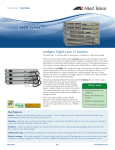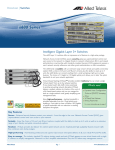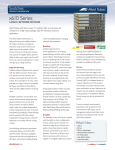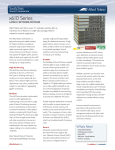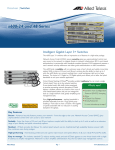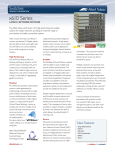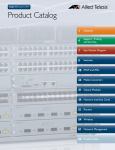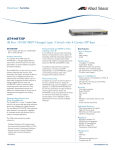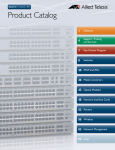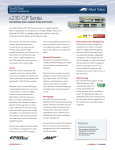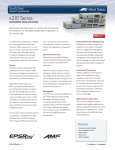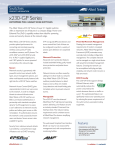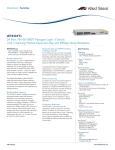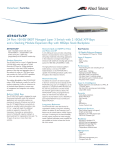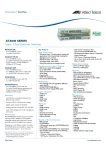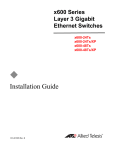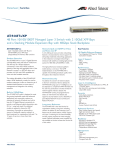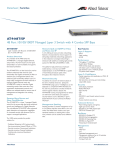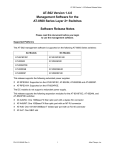Download Allied Telesis AT-X600-24TS-POE
Transcript
Switches PRODUCT INFORMATION x600 Series Intelligent gigabit LAYER 3+ SWITCHES The Allied Telesis x600 Series is an advanced series of stackable switches providing high performance, flexibility and reliability. Scalable The choice of 24-port and 48-port versions, coupled with the ability to stack up to 4 units, allows the Allied Telesis x600 Series to connect anything from a small workgroup right up to a large business. With a choice of 1 or 10 Gigabit uplink ports, bandwidth can be tailored to suit the network application. Hot-swappable XFPs provide high-speed, high-capacity fiber uplinks, with up to 40Gbps uplink capacity from each switch to the network core — so a 4-unit stack can provide a massive 160Gbps of uplink bandwidth independent from stacking bandwidth. The flexibility of the x600 Series, coupled with the ability to stack multiple units, ensures a future-proof network. Secure Advanced security features protect the network from the edge to the core. Network Access Control (NAC) assures security, allowing unprecedented control over user access to the network and mitigating threats to network infrastructure. 802.1x port-based authentication, in partnership with standards-compliant dynamic VLAN alliedtelesis.com assignment, assesses a user’s network security adherence and either grants authentication or offers remediation. Authentication options on the x600 Series also include alternatives to 802.1x port-based authentication, such as web authentication to enable guest access, and MAC authentication for end points that do not have an 802.1x supplicant. All three authentication methods — 802.1x, MAC-based and Web-based, — can be enabled simultaneously on the same port. This is called tri-authentication. Manageable The x600 Series runs the advanced AlliedWare Plus™ fully featured operating system, delivering a rich feature set and an industry-standard CLI. The industry-standard CLI reduces training requirements and is consistent across all AlliedWare Plus devices, simplifying network management. The built-in, web-based Graphical User Interface is an easy-to-use and powerful management tool. With comprehensive monitoring facilities and the ability to view a virtual chassis as a single entity, the GUI is an essential part of a network management toolkit. New Features »» EPSR SuperLoop Protection »»Optical DDM »» PIM - SSM »»TACACS+ Accounting »» IPv6 Features x600 Series | Intelligent Gigabit Layer 3+ Switches Key Features Network Access Control (NAC) Industry-leading Quality of Service (QoS) sFlow »» NAC allows for unprecedented control over user access to the network, in order to mitigate threats to network infrastructure. Furthermore, if multiple users share a port multi-authentication is used. Different users on the same port can be assigned into different VLANs, and so given different levels of network access. Additionally, a Guest VLAN can be configured to provide a catch-all for users who aren’t authenticated. »»Comprehensive low-latency wirespeed QoS provides flow-based traffic management with full classification, prioritization, traffic shaping and min/max bandwidth profiles. Enjoy boosted network performance and guaranteed delivery of business-critical ethernet services and applications. Time-critical services such as voice and video take precedence over non-essential services such as file downloads, maintaining responsiveness of Enterprise applications. »»sFlow is an industry standard technology for monitoring high speed switched networks. It provides complete visibility into network use, enabling performance optimization, usage accounting/billing, and defense against security threats. Sampled packets sent to a collector ensure it always has a real-time view of network traffic. Network in a Box Power over Ethernet Plus (PoE+) »» Simplifies administration by integrating several network services into the x600 switch. »» Radius Server checks the identity of users to keep the network safe. »» Storm Control ensures a robust network by managing the amount of traffic allowed on the network, and dealing with any unexpected surges. »» DHCP server automates the distribution of network addresses to PCs. »» A centralized Timekeeper ensures the network is always working in full synchronicity. »» Loop Protection guards against accidental wiring mistakes. »»With the AT-x600-24Ts-POE and POE+, a separate power connection to media endpoints such as IP phones and wireless access points is not required. PoE+ provides even greater flexibility, as it is capable of connecting devices that require more power (up to 30 Watts), for example tilt and zoom security cameras. Diagram 1 shows an example of PoE+ power provisioning. VCStack™ (Virtual Chassis Stacking) »»Create a VCStack with up to four units. VCStack provides a highly available system where network resources are spread out across stacked units, reducing the impact if one of the units fails. Aggregating switch ports on different units across the stack provides excellent network resiliency. Terminal Access Controller Access–Control System Plus (TACACS+) Authentication and Accounting »»TACACS+ provides access control and accounting for network users from a centralized server. Authentication is carried out via communication between the local switch and a TACACS+ server, to check the credentials of users seeking network access. Accounting enables user sessions and CLI commands to be logged to create an audit trail for user activity. Link Layer Discovery Protocol–Media Endpoint Discovery (LLDP–MED) Optical DDM »» Most modern optical SFP/SFP+/XFP transceivers support Digital Diagnostics Monitoring (DDM) functions according to the specification SFF-8472. This enables various parameters of the transceiver to be monitored in real-time, such as optical output power, temperature, laser bias current and transceiver supply voltage. The x600 Series provides easy access to this information simplifying diagnosing problems with optical modules and fiber connections. »» LLDP-MED extends LLDP’s basic network endpoint discovery and management functions. LLDP-MED allows for media endpoint specific messages, providing detailed information on power requirements, network policy, location discovery (for Emergency Call Services) and inventory. Voice VLAN »»Voice VLAN automatically separates voice and data traffic into two different VLANS. This automatic separation places delay-sensitive traffic into a voice dedicated VLAN, which simplifies QoS configurations. EPSRing™ (Ethernet Protection Switched Rings) »» EPSR and 10 Gigabit Ethernet allow several x600 Series to form a high speed protected ring capable of recovery within as little as 50ms. This feature is perfect for high performance and high availability in enterprise networks. »» SuperLoop Protection enables a link between two EPSR nodes to be in separate EPSR domains, improving redundancy and network fault resiliency. Diagram 1: PoE+ provision 90 x SB 8 Servers SwitchBlade x908 x600-24Ts-PoE+ 1 Gigabit link Link aggregation 2 | x600 Series x600 Series | Intelligent Gigabit Layer 3+ Switches Key Solution NAC (Network Access Control) Policy and RADIUS Server Policy Decision Point x600-24Ts Tri-authentication capable switch 802.1x authenticated device Policy Enforcement Point Web authenticated device MAC authenticated device Access Requestor Diagram 2: NAC with Tri-authentication One of the major security issues facing enterprise networks is prevention of internal breaches and malicious software infiltration. Internal defense requires significant involvement with individual network devices, which is costly and time consuming. NAC lowers this overhead and provides an effective solution to internal network security. VLAN assignment, to assess a user’s adherence to network security policies, and then either grant authentication or offer remediation. Allied Telesis NAC also supports alternatives to 802.1x port-based authentication, such as web authentication to enable guest access, and MAC authentication for end points that do not have an 802.1x supplicant. NAC automates network security policy management, allowing easy control of network access and management of network security. NAC uses 802.1x port-based authentication in partnership with standards-compliant dynamic Tri-Authentication provides a way for the network to successfully manage authentication of all devices. Protection (NAP) technology. Allied Telesis is committed to providing secure networks, and interoperability with Microsoft’s network access control solution is an important component of an already comprehensive security set. The Allied Telesis NAC solution also interoperates with many other third party NAC solutions. Allied Telesis is a partner with Microsoft, supporting Microsoft Network Access x600 Series | 3 x600 Series | Intelligent Gigabit Layer 3+ Switches Key Solution VCStack (Virtual Chassis Stacking) VCStack: Resiliency and Stability Today’s modern Enterprise business relies on Information Technology resources and applications to access business-critical information, and for day-to-day work. A high-availability infrastructure is of paramount importance. The Allied Telesis x600 Series switches provide the ideal solution with VCStack. With VCStack, multiple switches appear as a single virtual chassis. In normal operation, this virtual chassis acts as a single switch, simplifying management. Diagram 4 shows four AT-x600-48Ts/XP switches connected as a virtual chassis for maximum Gigabit to the desktop or aggregation layer port density. With the stacking bandwidth provided separately from the 10 Gigabit uplink ports, this solution provides a massive 160 Gigabits of uplink bandwidth to the network core, while the stacking backplane throughput is completely unaffected for maximum performance. Whether used to provide a virtual network core, or to maximize port density, the x600 family switches together with VCStack provide resiliency, scalability and ease of management. VCStack makes networking reliable. Internet Servers 5S 41 AR Router s 4T 24 -2 000 60 x6 x S 00 81 Diagram 3 shows link aggregation between the core VCStack and the edge switches. With link aggregation across ports on different virtual chassis members, there is no perceptible disruption in the case of a link failure, and the full bandwidth of the network remains available. Fast Failover ensures absolutely minimal network downtime in the event of a problem. 1 Gigabit link 10/100 link Link aggregation Diagram 3: VCStack - resilient network VCStack and link aggregation provide a solution where network resources are spread across the virtual chassis members, ensuring device and path resiliency. Virtualization of the network core ensures access to information when needed. Servers 08 x9 SB x6 00 S 00 81 CORE x600-48Ts/XP S 00 81 The x600 Series provides an extensive range of port-density and uplinkconnectivity options, when used as aggregation layer switches or Gigabit to the desktop edge switches. This scalable switch family can connect anything from a small workgroup to a large business. AGGREGATION x600-24Ts-PoE+ EDGE Diagram 4: VCStack - scalable port density 4 | x600 Series 10 Gigabit link 1 Gigabit link 10/100 link Link aggregation x600 Series | Intelligent Gigabit Layer 3+ Switches Specifications 10/100/1000T (RJ-45) copper ports 1000X SFP ports 1000X SFP combo ports 10Gigabit XFP ports Max PoE/PoE+ ports Switching Fabric Forwarding Rate AT-x600-24Ts 24 - 4 - - 96Gbps 71.4Mpps AT-x600-24Ts-POE 24 - 4 - 24 PoE 96Gbps 71.4Mpps AT-x600-24Ts-POE+ 24 - 4 - 24 PoE/12 PoE+ 96Gbps 71.4Mpps AT-x600-24Ts/XP 24 - 4 2 - 136Gbps 101.2Mpps AT-x600-48Ts 44 4 - - - 144Gbps 107.1Mpps AT-x600-48Ts/XP 44 4 - 2 - 184Gbps 136.9Mpps PRODUCT Performance »48Gbps of stacking bandwidth »Extensive wirespeed traffic classification for ACLs and QoS »Supports 9KB jumbo frames »Wirespeed multicasting »Up to 16K MAC addresses »4K VLANs »4K Layer 3 entries »512MB DDR SDRAM »64MB flash memory »Packet buffer memory: AT-x600-24T - 2MB AT-x600-48T - 4MB Reliability »» Modular AlliedWare PlusTM operating system »» Redundant power supply available to load share with internal power supply, providing uninterrupted power and extra reliability »» Full environmental monitoring of PSUs, fans, temperature and internal voltages. SNMP traps alert network managers in case of any failure Power Characteristics »»AC Voltage: 100 to 240V (+/-10% auto ranging) »» Frequency: 47 to 63Hz Expandability »»One expansion bay for AT-StackXG module supporting two high speed stacking ports (on non-PoE models, stacking ports are built-in on PoE models) »» Stackable up to four units in a VCStack »» IPv6 routing license option »»Advanced Layer 3 license option Flexibility and Compatibility »»Gigabit SFP ports will support any combination of 1000T, 1000X SFPs, 1000SX, 1000LX, or 1000ZX SFPs »» Mix up to four x600 and x610 units in the same VCStack Diagnostic Tools »» Built-In Self Test (BIST) »» Ping polling »» Port mirroring »»Traceroute »»Optical Digital Diagnostic Monitoring (SFF-8472) General Routing »» Black hole routing »» Directed broadcast forwarding »» DNS relay »» Equal Cost Multi-Path (ECMP) routing »» Policy-based routing »» Route maps »» Route redistribution (OSPF, BGP, RIP) »» UDP broadcast helper (IP helper) IPv6 Features »» 6to4 tunnelling »» DHCPv6 relay, DNSv6, NTPv6 »» IPv4 and IPv6 dual stack »» IPv6 management via ping, Traceroute, Telnet and SSH Management »» Eco-friendly mode allows ports and LEDs to be disabled to save power »»Console management port on the front panel for ease of access »»Web-based Graphical User Interface (GUI) »» Industry-standard CLI with context-sensitive help »» Powerful CLI scripting tool »» SD/SDHC memory card socket allowing software release files, configurations and other files to be stored for backup and distribution to other devices. »»Configurable logs and triggers provide an audit trail of SD card insertion and removal »» Secure Copy (SCP) »» Built-in text editor »» Event-based triggers allow user-defined scripts to be run upon selected system events Quality of Service (QoS) »» Limit bandwidth per port or per traffic class to 64kbps »»Wirespeed traffic classification with low latency essential for VoIP and real-time streaming media applications »» Policy-based QoS based on VLAN, port, MAC and general packet classifiers »» Policy-based storm protection »» Extensive remarking capabilities »» Strict priority scheduling, weighted round robin or mixed »» RED and WRED curves for drop precedence Resiliency »»Control plane prioritization ensures the CPU always has sufficient bandwidth to process network control traffic »» Dynamic link failover »» EPSRing (Ethernet Protection Switched Rings) »» EPSR Super Loop Protection »» Loop protection: loop detection and thrash limiting »» PVST+ compatibility-mode »» STP root guard »»VCStack fast failover minimizes network disruption Security Features »»Access Control Lists (ACLs) »»Auth fail VLAN »» BPDU protection »» DHCP snooping, IP source guard and dynamic ARP inspection »» DoS attack blocking and virus throttling »» Dynamic VLAN assignment »» Guest VLAN »» MAC-based authentication »» Port-based learn limits (intrusion detection) »» Private VLANs, providing security and port isolation of multiple customers using the same VLAN »» Strong password security »» Web-based authentication Environmental Specifications »»Operating temperature range: 0°C to 40°C (32°F to 104°F) Derated by 1°C per 305 meters (1,000 ft) »» Storage temperature range: -25°C to 70°C (-13°F to 158°F) »»Operating relative humidity range: 5% to 90% non-condensing »» Storage relative humidity range: 5% to 95% non-condensing »»Operating altitude: 3,048 meters maximum (10,000 ft) »» Front to back forced air cooling Electrical Approvals and Compliances »» EMC: EN55022 class A, FCC class A, VCCI class A »» Immunity: EN55024, EN61000-3-levels 2 (Harmonics), and 3 (Flicker) – AC models only Safety »» Standards: UL60950-1, CAN/CSA-C22.2 No. 60950-1-03, EN60950-1, EN60825-1, AS/NZS 60950.1 »»Certification: UL, cUL, TUV Restrictions on Hazardous Substances (RoHS) Compliance »» EU RoHS compliant »»China RoHS compliant Country of Origin »»China x600 Series | 5 x600 Series | Intelligent Gigabit Layer 3+ Switches Physical Specifications Product Width Depth Height Mounting AT-x600-24Ts 440 mm (17.32 in) 305 mm (12.0 in) 44 mm (1.73 in) AT-x600-24Ts-POE 440 mm (17.32 in) 408 mm (16.06 in) AT-x600-24Ts/PoE+ 440 mm (17.32 in) 408 mm (16.06 in) Weight Unpackaged Packaged 1 RU rack mount 4.5 kg (9.92 lb) 6.1 kg (13.44 lb) 44 mm (1.73 in) 1 RU rack mount 6.9 kg (15.21 lb) 8.5 kg (18.73 lb) 44 mm (1.73 in) 1 RU rack mount 6.9 kg (15.21 lb) 8.5 kg (18.73 lb) AT-x600-24Ts/XP 440 mm (17.32 in) 305 mm (12.0 in) 44 mm (1.73 in) 1 RU rack mount 4.6 kg (10.14 lb) 6.2 kg (13.66 lb) AT-x600-48Ts 440 mm (17.32 in) 305 mm (12.0 in) 44 mm (1.73 in) 1 RU rack mount 4.9 kg (10.80 lb) 6.5 kg (14.33 lb) AT-x600-48Ts/XP 440 mm (17.32 in) 305 mm (12.0 in) 44 mm (1.73 in) 1 RU rack mount 4.9 kg (10.80 lb) 6.5 kg (14.33 lb) 150 mm (5.9 in) 95 mm (3.74 in) 30 mm (1.18 in) Internal 0.2 kg (0.44 lb) 0.5 kg (1.1 lb) AT-StackXG Power and Noise Characteristics No PoE load Product 15W per port PoE load max power Consumption max heat Dissipation Noise Max power Consumption Heat Dissipation 87W 297 BTU/hr 45.8 dBA - - AT-x600-24Ts AT-x600-24Ts-POE 78W 268 BTU/hr 48.1 dBA 462W 1,579 BTU/hr AT-x600-24Ts-POE+ 78W 268 BTU/hr 46.8 dBA 462W 1,579 BTU/hr AT-x600-24Ts/XP 87W 297 BTU/hr 45.8 dBA - - AT-x600-48Ts 112W 382 BTU/hr 46.8 dBA - - AT-x600-48Ts/XP 112W 382 BTU/hr 46.8 dBA - NOISE tested to ISO7779; front bystander position Latency (microseconds) Product speed 10 mbps 100 mbps 1 gbps AT-x600-24Ts 83.5µs 11.1µs 4.2µs AT-x600-24Ts/X 83.5µs 11.1µs 4.2µs AT-x600-48Ts 83.5µs 11.1µs 4.2µs AT-x600-48Ts/X 83.5µs 11.1µs 4.2µs Standards and Protocols AlliedWare Plus Operating System Version 5.4.2 or higher Authentication RFC 1321 MD5 Message-Digest algorithm RFC 1828 IP authentication using keyed MD5 Border Gateway Protocol (BGP) BGP dynamic capability BGP graceful restart BGP outbound route riltering Extended communities attribute RFC 1771 Border Gateway Protocol 4 (BGP-4) RFC 1772 Application of the Border Gateway Protocol in the Internet RFC 1997 BGP communities attribute RFC 2385 Protection of BGP sessions via the TCP MD5 signature option RFC 2439 BGP route flap damping RFC 2796 BGP route reflection - an alternative to full mesh IBGP RFC 2858 Multiprotocol extensions for BGP-4 RFC 2918 Route refresh capability for BGP-4 RFC 3065 Autonomous system confederations for BGP RFC 3107 Carrying label information in BGP-4 RFC 3392 Capabilities advertisement with BGP-4 RFC 4893 BGP support for four-octet AS number space 6 | x600 Series 10 gbps 6.2µs 7.8µs Encryption FIPS 180-1 Secure Hash Standard (SHA-1) FIPS 186 Digital signature standard (RSA) FIPS 46-3 Data Encryption Standard (DES and 3DES) Ethernet IEEE 802.1AX-2008 link aggregation (static and dynamic) IEEE 802.2 Logical Link Control IEEE 802.3 Ethernet CSMA/CD IEEE 802.3ab1000BASE-T IEEE 802.3ae10 Gigabit Ethernet IEEE 802.3af Power over Ethernet (PoE) IEEE 802.3at Power over Ethernet Plus (PoE+) IEEE 802.3u 100BASE-X IEEE 802.3x Flow control - full-duplex operation IEEE 802.3z Gigabit Ethernet General Routing RFC 768 User Datagram Protocol (UDP) RFC 791 Internet Protocol (IP) RFC 792 Internet Control Message Protocol (ICMP) RFC 793 Transmission Control Protocol (TCP) RFC 826 Address Resolution Protocol (ARP) RFC 894 Standard for the transmission of IP datagrams over Ethernet networks RFC 919 Broadcasting Internet datagrams RFC 922 Broadcasting Internet datagrams in the presence of subnets RFC 932 Subnetwork addressing scheme RFC 950 Internet standard subnetting procedure RFC 951 Bootstrap Protocol (BootP) relay and server RFC 1027 Proxy ARP RFC 1035 DNS client RFC 1042 Standard for the transmission of IP datagrams over IEEE 802 networks RFC 1071 Computing the Internet checksum RFC 1122 Internet host requirements RFC 1191 Path MTU discovery RFC 1256 ICMP router discovery messages RFC 1518 An architecture for IP address allocation with CIDR RFC 1519 Classless Inter-Domain Routing (CIDR) RFC 1542 Clarifications and extensions for the bootstrap protocol RFC 1591 Domain Name System (DNS) RFC 1812 Requirements for IPv4 routers RFC 1918 IP addressing RFC 2581 TCP congestion control IPv6 Features RFC 1981 Path MTU discovery for IPv6 RFC 2460 IPv6 specification RFC 2464 Transmission of IPv6 packets over Ethernet networks RFC 3056 Connection of IPv6 domains via IPv4 clouds RFC 3484 Default address selection for IPv6 RFC 3596 DNS extensions to support IPv6 RFC 4007 IPv6 scoped address architecture x600 Series | Intelligent Gigabit Layer 3+ Switches RFC 4193 RFC 4291 RFC 4443 RFC 4861 RFC 4862 RFC 5014 RFC 5095 RFC 5175 RFC 6105 Unique local IPv6 unicast addresses IPv6 addressing architecture Internet Control Message Protocol (ICMPv6) Neighbor discovery for IPv6 IPv6 stateless address autoconfiguration IPv6 socket API for source address selection Deprecation of type 0 routing headers in IPv6 IPv6 router advertisement flags option IPv6 router advertisement guard Management AT Enterprise MIB IEEE 802.1abLink Layer Discovery Protocol (LLDP) RFC 1155 Structure and identification of management information for TCP/IP-based Internets RFC 1157 Simple Network Management Protocol (SNMP) RFC 1212 Concise MIB definitions RFC 1213 MIB for network management of TCP/IP-based Internets: MIB-II RFC 1215 Convention for defining traps for use with the SNMP RFC 1227 SNMP MUX protocol and MIB RFC 1239 Standard MIB RFC 1493 Bridge MIB RFC 1724 RIPv2 MIB extension RFC 2011 SNMPv2 MIB for IP using SMIv2 RFC 2012 SNMPv2 MIB for TCP using SMIv2 RFC 2013 SNMPv2 MIB for UDP using SMIv2 RFC 2096 IP forwarding table MIB RFC 2574 User-based Security Model (USM) for SNMPv3 RFC 2575 View-based Access Control Model (VACM) for SNMP RFC 2674 Definitions of managed objects for bridges with traffic classes, multicast filtering and VLAN extensions RFC 2741 Agent Extensibility (AgentX) protocol RFC 2787 Definitions of managed objects for VRRP RFC 2819 RMON MIB (groups 1,2,3 and 9) RFC 2863 Interfaces group MIB RFC 3164 Syslog protocol RFC 3176 sFlow: A method for monitoring traffic in switched and routed networks RFC 3412 Message processing and dispatching for the SNMP RFC 3413 SNMP applications RFC 3418 MIB for SNMP RFC 3621 PoE MIB RFC 3635 Definitions of managed objects for the Ethernet like interface types RFC 3636 IEEE 802.3 MAU MIB RFC 4188 Definitions of managed objects for bridges RFC 4318 Definitions of managed objects for bridges with RSTP RFC 4560 Definitions of managed objects for Remote Ping, Traceroute, and Lookup Operations Multicast Support Bootstrap router for PIM-SM IGMP proxy IGMP query solicitation IGMP snooping RFC 1112 Host extensions for IP multicasting RFC 2236 Internet Group Management Protocol v2 (IGMPv2) RFC 2362 PIM-SM RFC 2715 Interoperability rules for multicast routing protocols RFC 3376 IGMPv3 RFC 3973 PIM-DM RFC 4541 IGMP and MLD snooping switches RFC 4604 Using IGMPv3 and MLDv2 for Source Specific Multicast RFC 4607 Source-Specific Multicast for IP Open Shortest Path First (OSPF) Graceful OSPF restart OSPF link-local signaling OSPF MD5 authentication OSPF restart signaling OSPF TE extensions OSPFv3 TE extensions Out-of-band LSDB resync RFC 1245 OSPF protocol analysis RFC 1246 Experience with the OSPF protocol RFC 1370 Applicability statement for OSPF RFC 1765 OSPF database overflow RFC 2328 OSPFv2 RFC 2370 OSPF opaque LSA option RFC 2740 OSPFv3 for IPv6 RFC 3101 OSPF Not-So-Stubby Area (NSSA) option RFC 3509 Alternative implementations of OSPF area border routers Quality of Service (QoS) IEEE 802.1p priority tagging RFC 2211 Specification of the controlled-load network element service RFC 2474 DiffServ precedence for eight queues/port RFC 2475 DiffServ architecture RFC 2597 DiffServ Assured Forwarding (AF) RFC 2697 A single-rate three-color marker RFC 2698 A two-rate three-color marker RFC 3246 DiffServ Expedited Forwarding (EF) RFC 4254 Secure Shell (SSHv2) connection protocol Services RFC 854 Telnet protocol specification RFC 855 Telnet option specifications RFC 857 Telnet echo option RFC 858 Telnet suppress go ahead option RFC 1091 Telnet terminal-type option RFC 1350 Trivial File Transfer Protocol (TFTP) RFC 1985 SMTP service extension RFC 2049 MIME RFC 2131 DHCP for IPv4 RFC 2132 DHCP options and BOOTP vendor extensions RFC 2554 SMTP service extension for authentication RFC 2616 Hypertext Transfer Protocol - HTTP/1.1 RFC 2821 Simple Mail Transfer Protocol (SMTP) RFC 2822 Internet message format RFC 3046 DHCP relay agent information option (DHCP option 82) RFC 3993 Subscriber-ID suboption for DHCP relay agent option RFC 5905 Network Time Protocol version 4 (NTPv4) VLAN Support Generic VLAN Registration Protocol (GVRP) IEEE 802.1ad Provider bridges (VLAN stacking, Q-in-Q) IEEE 802.1Q-2005 Virtual LAN (VLAN) bridges IEEE 802.1v VLAN classification by protocol and port IEEE 802.3ac VLAN tagging Voice over IP (VoIP) Support LLDP-MED ANSI/TIA-1057 Voice VLAN Resiliency Features IEEE 802.1D-2004 MAC bridges IEEE 802.1D-2004 Rapid Spanning-Tree Protocol (RSTP) IEEE 802.1Q-2005 Multiple Spanning-Tree Protocol (MSTP) RFC 3768 Virtual Router Redundancy Protocol (VRRP) Routing Information Protocol (RIP) RFC 1058 Routing Information Protocol (RIP) RFC 2080 RIPng for IPv6 RFC 2081 RIPng protocol applicability statement RFC 2082 RIP-2 MD5 authentication RFC 2453 RIPv2 Security Features SSH remote login SSLv2 and SSLv3 TACACS+ accounting TACACS+ authentication IEEE 802.1x authentication protocols (TLS, TTLS, PEAP and MD5) IEEE 802.1x multi-supplicant authentication IEEE 802.1x port-based Network Access Control RFC 2246 TLS protocol v1.0 RFC 2865 RADIUS RFC 2866 RADIUS accounting RFC 2868 RADIUS attributes for tunnel protocol support RFC 3546 Transport Layer Security (TLS) extensions RFC 3579 RADIUS support for Extensible Authentication Protocol (EAP) RFC 3580 IEEE 802.1x RADIUS usage guidelines RFC 3748 PPP Extensible Authentication Protocol (EAP) RFC 4251 Secure Shell (SSHv2) protocol architecture RFC 4252 Secure Shell (SSHv2) authentication protocol RFC 4253 Secure Shell (SSHv2) transport layer protocol x600 Series | 7 x600 Series | Intelligent Gigabit Layer 3+ Switches Ordering Information Feature Licenses Name Description Includes AT-FL-x600-01 x600 advanced Layer 3 license »» OSPF1 »» PIM-SM »» PIM-DM »» BGP4 »» VLAN double tagging (Q-in-Q) AT-FL-x600-02 AT-FL-RADIUS-FULL 1 2 x600 IPv6 pack »» IPv6 management »» IPv6 static routes »» IPv6 unicast forwarding »» RIPng »» OSPFv3 »» MLD snooping Increase local RADIUS server support limits2 Redundant Power Supplies for non PoE models AT-RPS3204-xx Chassis for up to 4 redundant power supplies (Chassis includes one power supply and one cable) AT-PWR3202 Additional 200W redundant power supply with RPS cable »» 5000 users »» 1000 NAS The standard switch software supports 64 OSPF routes. The advanced Layer 3 license supports 8K OSPF routes. 100 users and 24 NAS can be stored in local RADIUS database with base software. Redundant Power Supplies for PoE model x600 Series AT-x600-24Ts-xx 24 x 10/100/1000T (RJ-45) copper ports, 4 x 1000X SFP combo ports, 1 x expansion bay for AT-Stack-XG module AT-x600-24Ts-POE-xx 24 x 10/100/1000T (RJ-45) Power over Ethernet (IEEE 802.3af) copper ports, 4 x 1000X SFP combo ports, 2 x 24 Gbps on-board stacking ports AT-x600-24Ts-POE+-xx 24 x 10/100/1000T (RJ-45) Power over Ethernet plus (IEEE 802.3at) copper ports, 4 x 1000X SFP combo ports, 2 x 24 Gbps on-board stacking ports AT-x600-24Ts/XP-xx 24 x 10/100/1000T (RJ-45) copper ports, 4 x 1000X SFP combo ports, 2 x XFP ports, 1 expansion bay for AT-Stack-XG module AT-x600-48Ts-xx 44 x 10/100/1000T (RJ-45) copper ports, 4 x 1000X SFP ports, 1 expansion bay for AT-Stack-XG module SFP Modules AT-SPTX 1000T 100 m copper AT-SPSX 1000SX GbE multi-mode 850 nm fiber up to 550 m AT-SPSX/I 1000SX GbE multi-mode 850 nm fiber up to 550 m industrial temperature AT-SPEX 1000X GbE multi-mode 1310 nm fiber up to 2 km AT-SPLX10 1000LX GbE single-mode 1310 nm fiber up to 10 km AT-StackXG/0.5-00 0.5 meter cable for stacking AT-SPLX10/I 1000LX GbE single-mode 1310 nm fiber up to 10 km industrial temperature AT-StackXG/1-00 1 meter cable for stacking AT-SPBD10-13 1000LX GbE Bi-Di (1310 nm Tx, 1490 nm Rx) fiber up to 10 km 10 GbE XFP Modules AT-SPBD10-14 1000LX GbE Bi-Di (1490 nm Tx, 1310 nm Rx) fiber up to 10 km AT-XPLR 10GbE-LR 1310 nm medium-haul, 10 km with SMF AT-XPER40 10GbE-ER 1550 nm long-haul, 40 km with SMF Stacking Accessories AT-StackXG-00 Stacking module with one AT-StackXG/0.5-00 cable included. (Not required for x600-24Ts-PoE or PoE+) AT-x600-48Ts/XP-xx 44 x 10/100/1000T (RJ-45) copper ports, 4 x 1000X SFP ports, 2 x XFP ports, 1 expansion bay for AT-Stack-XG module AT-XPSR 10GbE-SR 850 nm short-haul, 300 m with MMF AT-RPS3104-xx Chassis for up to 4 redundant power supplies (Chassis includes one power supply and one cable) AT-PWR3101 Additional 450W redundant power supply with RPS cable AT-SPLX40 1000LX GbE single-mode 1310 nm fiber up to 40 km AT-SPZX80 1000ZX GbE single-mode 1550 nm fiber up to 80 km Where xx = 10 for US power cord 20 for no power cord 30 for UK power cord 40 for Australian power cord 50 for European power cord North America Headquarters | 19800 North Creek Parkway | Suite 100 | Bothell | WA 98011 | USA | T: +1 800 424 4284 | F: +1 425 481 3895 Asia-Pacific Headquarters | 11 Tai Seng Link | Singapore | 534182 | T: +65 6383 3832 | F: +65 6383 3830 EMEA & CSA Operations | Incheonweg 7 | 1437 EK Rozenburg | The Netherlands | T: +31 20 7950020 | F: +31 20 7950021 alliedtelesis.com © 2013 Allied Telesis, Inc. All rights reserved. Information in this document is subject to change without notice. All company names, logos, and product designs that are trademarks or registered trademarks are the property of their respective owners. 617-000471 Rev L









